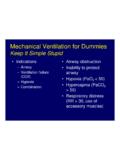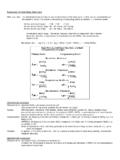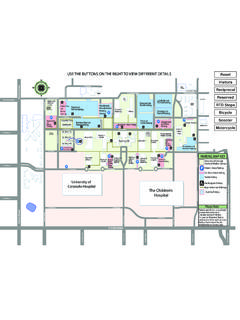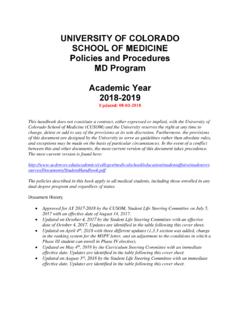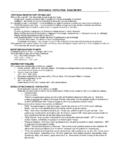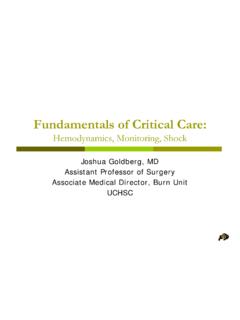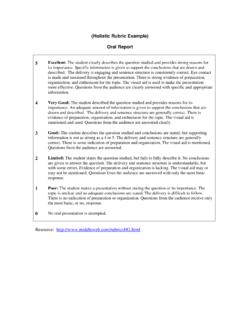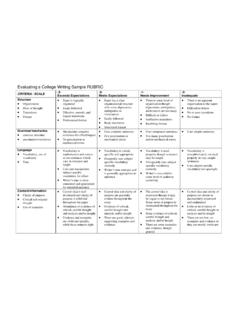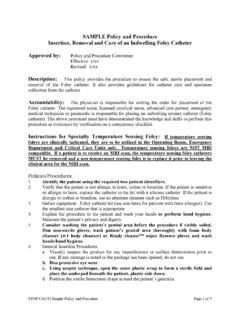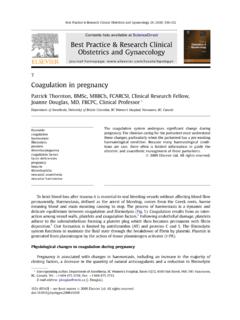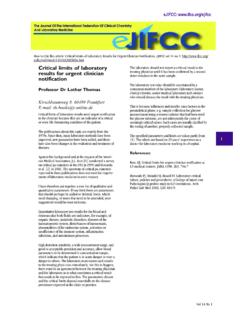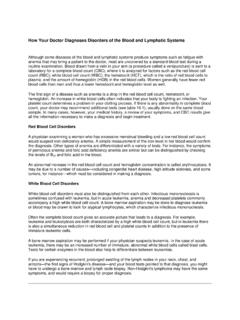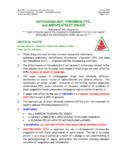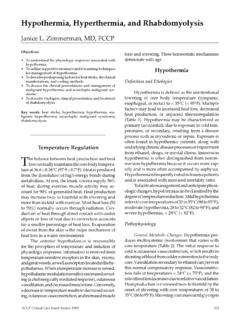Transcription of Coagulation Made Simple - Denver, Colorado
1 Thomas A. Whitehill, of Vascular SurgeryCoagulation Made SimpleObjectives of This Presentation Identify and describe the critical elements of the hemostatic mechanisms of the body Develop and implement an effective diagnostic and therapeutic approach to the abnormally bleeding patientBlack Box View of HemostasisPlatelet/ Coagulation factor activationLots of exciting biochemistryCLOT!Key Points Hemostasis requires the interaction of platelets, Coagulation and fibrinolyticfactors, endothelium, proinflammatoryand anti-inflammatory mediators, and leukocytes Clot formation is typically initiated by vascular injury, in which a platelet plug forms and is reinforced with fibrin produced via the extrinsic pathway Physiologic anticoagulants such as AT-III and Activated Protein C oppose thrombosis, serving to localize it to sites of vascular injury Clot formation is balanced by plasmin-mediated fibrinolysis.
2 Resulting in the formation of D-dimersand other fibrin degradation productsVascular InjuryExposure of Subendothelial CollagenPlatelet Adhesion, Aggregation, and Activation(Primary Hemostasis)SecondStable Fibrin/Platelet ClotFibrinolysis [as needed]VasoconstrictionFirstRelease of Tissue FactorCoagulation Cascade(Secondary Hemostasis)ThirdPlateletsReceptor Exposure,ActivationBind Clotting FactorsThrombosisPlatelet Plug (Surface)VasoconstrictionThromboxane A2 ActivationAdherenceAggregationFibrinogen Granule ReleasevWFGPIbCollagenThrombinADPEpiTxA2 GPIIbGPIIIaADPPDGF5-HTPLC oagulation Factors IFibrinogen IIProthrombin IIIT hromboplastin IVCalcium VProaccelerin VISame as V VII Proconvertin VIII Antihemophilic IXChristmas XStuart-Prower XIPlasma thrombo-plastin antecedent XIIH ageman XIII Fibrin stabilizingCoagulation Factor Fun FactsPlasmaPlasmaPlasmaFactor concentrateFactor concentrate, DDAVPP lasma, rVIIaPlasma, plateletsPlasmaCryoprecipitateTherapy< 10%4-7 daysLiverXIII--60 hr?
3 XII10% -25%40-80 hrLiverXI10% -40%25-60 hrLiver*X50% -70%24 hrLiver*IX100%8-12 hrECVIII10 -15%5 hrLiver*VII15 -25%15-36 hrLiver, ECV15% -40%50-80 hrLiver*II> 100 mg/dl72-100 hrLiverILevel for SurgeryT 1/2 ProductionFactorContactTissue Factor + VIIXIIIaXIIIT hrombinFibrin(strong)FibrinogenFibrin(we ak)IXXIXIaIXaXaVaXIIaProthrombinTF-VIIaP LPLVIIIaPLXI ntrinsic PathwayHKaExtrinsic PathwayCommon Pathway Classic (Test Tube) Coagulation CascadeSince 1961 Tissue Factor + VIIXIIIaXIIIT hrombin (IIa) Fibrin(strong)Fibrinogen (I)Fibrin(weak)IXIXaXaVaProthrombin(II)T F-VIIaPLVIIIaPL Ca++X New (in vivo) Coagulation CascadePLXIXIaFactor VII Tissue Factor two-unit enzyme Factor VIIa catalytic component Tissue factor regulatory component (not on EC or circulating blood cells) TF-VIIa(extrinsicXase) complex catalyzes X to Xa Extrinsic Xaseactivates IX Factor VIIIa+ IXaform the intrinsicfactor Xase Intrinsic Xase50x more effective at catalyzing factor X activation than extrinsic XaseTFVIIPLThe Many Roles of ThrombinPositive inotropeHeartThrombinAntithrombinTumor cellsAdhesionMetastasisCell growthClot formation.
4 Fibrinogen FibrinF XIII F XIIIaAmplification/ActiviationF V F VaF VIII F VIIIaCoagulation SystemAggregationRelease reactionTxA2-synthesisPlateletsLeukocyte sChemotaxisCytokine productionChemotaxisMacrophagesSynthesis andrelease:ProstacyclinEDRF, t-PAEndothelinTissue factorActivation:Protein C PCaThrombomodulinEndothelial CellsFibroblastsProliferationNeuritegrow th regulationNeuronsContractionMitogenesisS mooth MuscleTissue Factor + VIIXIIIaXIIIT hrombinFibrin(strong)FibrinogenFibrin(we ak)IXIXaXaVaProthrombin(II)TF-VIIaPLVIII aPLXP hysiologic Anticoagulant MechanismsPLTFPIP roteins C & S(+ thrombomodulin)Antithrombin IIIF ibrinolysisToday s Rehearsals Will my patient bleed?
5 Why am I seeing excessive intraoperative or post-operative bleeding! I think my patient has HIT!Will my patient bleed? Are you a bleeder? is not enough Hx of prolonged or frequent bleeding Biting lip or tongue, gums bleed with brushing Nosebleeds (excessive and recurrent) Bruises without apparent injury Prolonged bleeding after dental extraction Excessive menstrual bleeding Previous operative bleeding Relative with a bleeding problem Medications (ASA, Plavix, alternatives )Platelet Defect or Factor Deficiency? Platelet defect or von Willebrand disease Mucocutaneousbleeding Excessive bruising, gingival bleeding, frequent nose bleeds Coagulation factor defects Muscle and joint bleeds Both groups will bleed excessively from injuries and at the time of surgery!
6 Inherited Defects of Platelet Function Platelet function disorders with normal platelet numbers Collagen aggregation defects (variable inheritance) Glanzmannthrombasthenia(AR) Dense body deficiency (AR) Secretion defect (varies) Thrombocytopenia (large platelets) Alport ssyndrome (AD) Autosomaldominant thrombocytopenia (AD) Bernard-Soulier(AR) Gray platelet syndrome (AD) May Hegglinanomaly (AD) Fechntersyndrome (AD) Montreal giant platelet syndrome (AD) Thrombocytopenia (normal sized platelets) Ch diak-Higashi syndrome (AR) Thrombocytopenia with absent radius (TAR, AR) Factor V Quebec (AD) Thrombocytopenia (small platelets) Wiskott-Aldrich syndrome (X-linked)Acquired or Inherited Factor Disorder?
7 Acquired bleeding factor disorderswill often present suddenly with severe bleeding and newly abnormal Coagulation tests Patients have other illnesses but autoimmune Coagulation disorders can suddenly strike any previously healthy personAcquired or Inherited Factor Disorder? Inherited bleeding factor disorders Present from birth until old age Mildhemophilia or von Willebrand disease patients may not have had troublesome bleeding until the first trauma or surgery Do not ignore an abnormal aPTTin an older patient Review family history Hemophilia A/B are sex-linked -brothers, cousins, uncles Von Willebrand disease may have variable penetrance within the familyVon WillebrandDisease (vWD)
8 The most common inherited bleeding disorder 1% of the population Five forms or types are known and distinguishable Classic reduced VIII activity and decreased vWF vWFis crucial for the interaction of platelets with damaged vasculature vWFis also the carrier protein for factor VIII (otherwise, free VIII is labile in the plasma) vWDusually results from either a drop in vWFconcentration or impaired vWF/VIII functionVon WillebrandDisease (vWD) Patients with vWDhave platelet-type bleeding (nosebleeds and bruising) Joint bleeding is rare Bleeding as a child, less as an adult Testing (a challenge) Bleeding time (variable sensitivity) Factor VIII level Von Willebrandantigen Ristocetincofactor activity (binds vWFto platelets) Crossed immunoelectrophoresis Therapy: DDAVP, Humate-P, cryoprecipitateWill my patient bleed?
9 Level I concern History is negative Procedure planned is relatively minor No screening tests are recommendedWill my patient bleed? Level II concern History is negative Screening tests have been negative in the past Major operationis planned (procedure not usually attended with significant bleeding) Platelet count, peripheral smear, PT-INR, aPTTWill my patient bleed? Level III concern Historyis suggestive of poor hemostasis Procedure may impair hemostasis(CPB or cell saver) or the procedure may leave behind a large, raw surface Minimal post-operative bleedingwill be injurious (craniotomy) Platelet count, PT-INR, aPTT, +/-bleeding time (PFA-100)Will my patient bleed?
10 Level IV concern History highly suggestive of a hemostatic defect Hematology consult Platelet count, bleeding time, PT-INR, aPTT,euglobulinclot lysisanalysis, factor assays Bleeding time test + ASA provocative test If emergent platelet aggregation testing and thrombin time (TEG, if available)Will my patient bleed? Patients with liver disease, renal failure, obstructive jaundice, possibility of disseminated malignant disease Platelet count, aPTT, PT-INR (uremicpatients usually have a vitamin-K deficiency) Patients with uremia (qualitative platelet function abnormality) Bleeding time (improved with dialysis or administration of DDAVP)Laboratory Monitoring of Coagulation ProthrombinTime (PT-INR) Plasma + Calcium + Tissue ThromboplastinTF + VIIa Xa+ V IIa CLOT PT-INR only elevated Factor VII deficiency Congenital (very rare) Acquired (VitK deficiency, liver disease)
